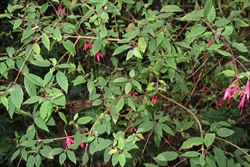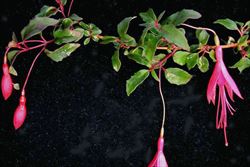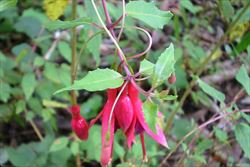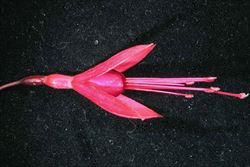Click on images to enlarge

habit (Photo: Sheldon Navie)

leaves and flowers (Photo: Greg Jordan)

leaves and flowers (Photo: Sheldon Navie)

flowers with purple petals (Photo: Sheldon Navie)

close-up of flower with red petals (Photo: Greg Jordan)
Scientific Name
Fuchsia magellanica Lam.
Synonyms
Fuchsia macrostema Ruiz & PavónFuchsia magellanica Lam. var. macrostemma (Ruiz & Pavón) Munz
Family
Onagraceae
Common Names
earring flower, fuchsia, hardy fuchsia, lady's eardrops
Origin
Native to the southern parts of South America (i.e. Argentina and Chile).
Naturalised Distribution
Naturalised in the coastal districts of southern Australia (i.e. in southern Victoria, Tasmania, south-eastern South Australia and the coastal districts of south-western Western Australia). Possibly also naturalised on the central tablelands of New South Wales.
Widely naturalised overseas in Bolivia, the UK, the Azores, the Canary Islands, eastern Africa, La Réunion, New Zealand, Hawaii and western USA (i.e. California and Oregon).
Notes
Hardy fuchsia (Fuchsia magellanica) is regarded as an environmental weed in Victoria, South Australia, Tasmania and Western Australia. This species has escaped cultivation as a garden plant and is listed as a priority environmental weed by at least one Natural Resource Management region. It is invasive in forests and forest margins, moist open woodlands, riparian areas and disturbed bushland areas in southern Australia.
In Victoria, hardy fuchsia (Fuchsia magellanica) is restricted to relatively small populations in damp and wet sclerophyll forests and riparian vegetation in the Dandenong, Otway and Strzelecki Ranges. However, it is ranked as a high priority environmental weed species in the Angahook-Otways area in Victoria because of its weed potential. This is because it has the ability to change the light distribution, cause a loss of biodiversity, and substantially reduce the regeneration of native plants in invaded communities.
In Tasmania, hardy fuchsia (Fuchsia magellanica) is proving to be highly invasive in the coastal districts of the state and in many situations throughout the Southern Natural Resource Management region. It is particularly competitive in areas of wet forest, but in drier areas soil disturbance is required for its establishment. Hardy fuchsia (Fuchsia magellanica) has also been recorded at several moist and shaded localities in the Adelaide Hills in South Australia, has escaped from gardens into overgrown areas around Denmark and Albany in south-western Western Australia, and was once recorded as possibly naturalised near the Mount Annan Botanic Gardens in New South Wales. Hardy fuchsia (Fuchsia magellanica) is most invasive on the La Réunion islands in the Indian Ocean, where it forms dense tangled thickets which shade out native understorey plants and alter the structure of the vegetation. It is capable of penetrating and transforming undisturbed high altitude forests and during a recent study was ranked among the top ten most invasive alien plant species on La Réunion. It is also naturalised in moderately wet and wet forests in Hawaii.

